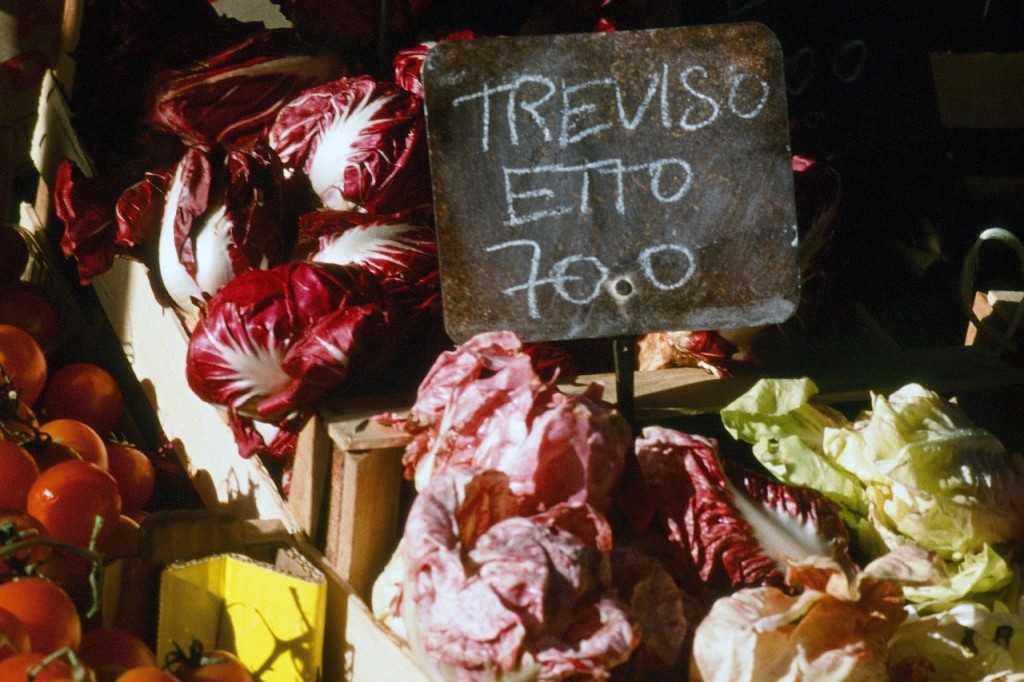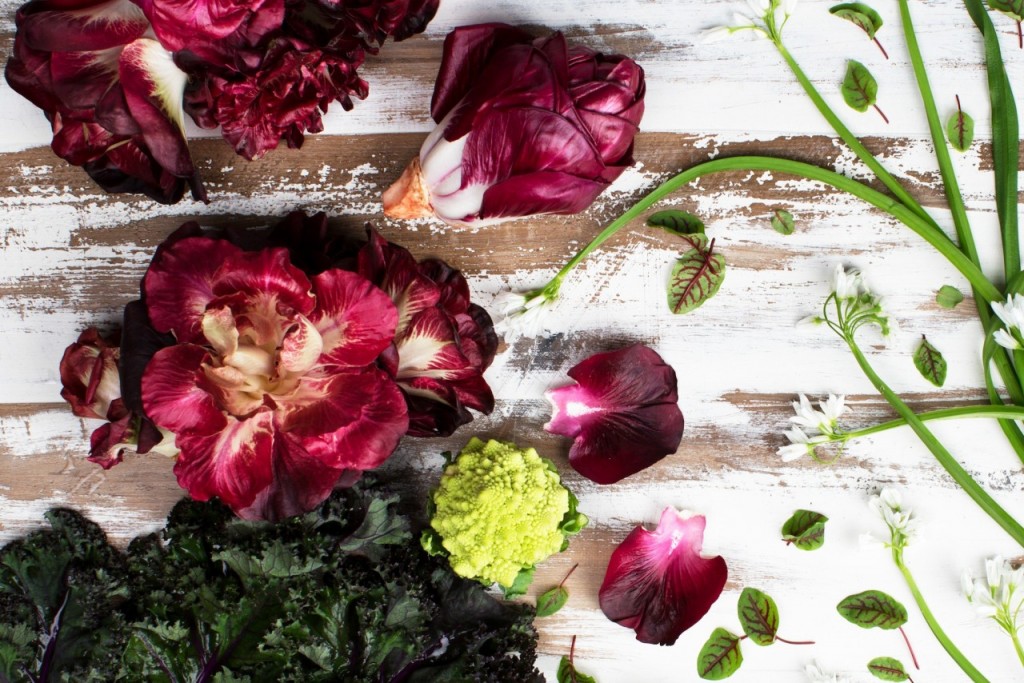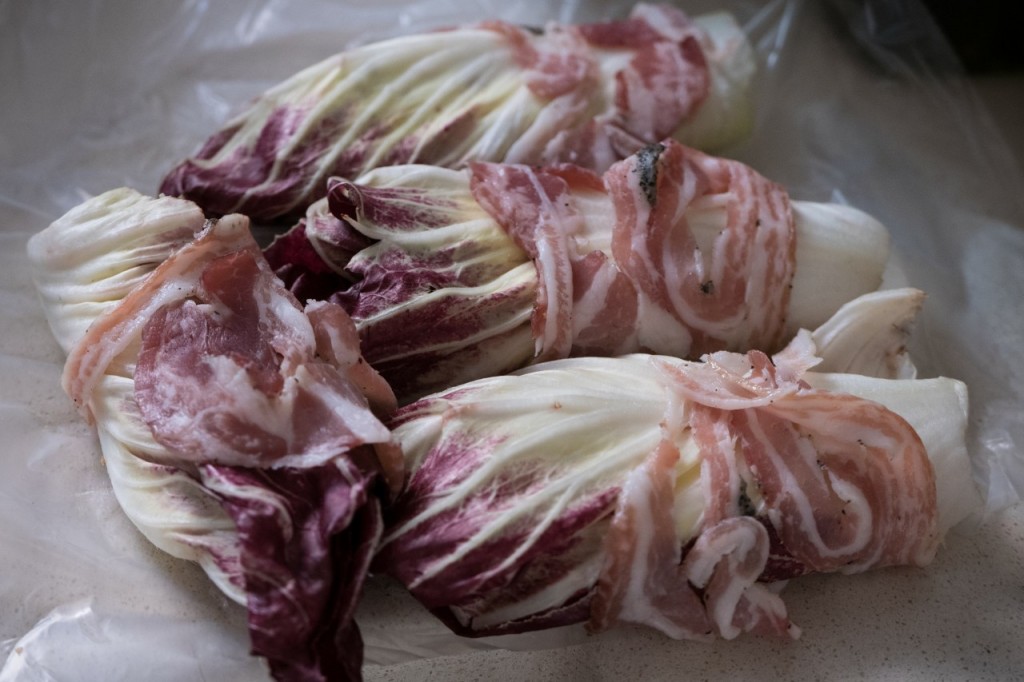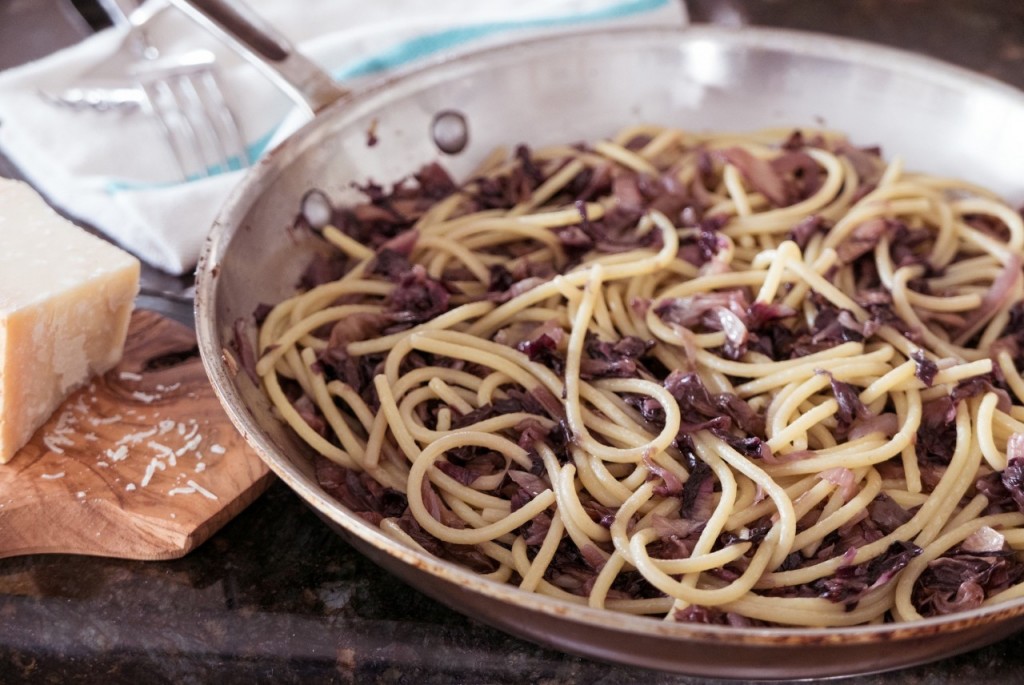Radicchio stuffed with goat cheese. Credit: (Copyright 2016) Nathan Hoyt/Forktales
By Julia della Croce (Zester Daily)
If radicchio has become wildly popular in the States, it still doesn’t get the respect it deserves: Americans have adopted the showy vegetable as their own, but rarely does it transcend the salad bowl. This drives the Italians crazy, because throughout the regions where growing it is a tradition and an art, it has endless uses. Stuff it; shred it and caramelize it in olive oil for a pasta sauce or focaccia topping; melt it into a buttery risotto; coat it in batter and fry. Why not bake it into a cheesy pie encased in a crumbly crust? Venetians have no end of such recipes for their adored radicchio, and the different varieties they grow are starting to show their beautiful heads in American markets.

Recently, I spoke with Emily Balducci, whose family introduced the vegetable to New York in the 1970s. Their legendary Greenwich Village grocery store evolved into Baldor Specialty Foods, which curates and distributes fresh produce to retailers and chefs. “Beginning in January, we get shipments twice a week,” she said. “The first of these winter beauties is Castelfranco, and the others follow. At the end of the season, we get rosa di Gorizia, the most gorgeous one of all.”
Know your radicchio

To begin with, it should be noted that the radicchio tribe belongs to the group of root chicories classified as Cichorium intybus; as such, the leaves have a bite to them when eaten raw. While we are most familiar with the wine-colored, globe-shaped Verona chicory, there are numerous varieties indigenous to northeastern Italy, all characterized by their spectacular reddish or reddish-green coloring. Besides radicchio rosso di Verona (also called “the rose of Chioggia,” just to confuse the matter), these include another spherical type that can grow as large as a cabbage head: the Castelfranco radicchio, which is shaped like an open peony and cream-hued with violet streaking as well as a green tint to its outermost leaves.
Both the Treviso radicchio (variegato di Treviso) and the late-winter tardivo di Treviso are elongated just like their cousin the Belgian endive, but the comparison stops there. With its leggy white stalks and furled, deep-purple leaf tips, tardivo (which means “late-blooming”) is the most esteemed by the Italians for its sweetness. Of all the radicchios, the most lovely of all might very well be the aforementioned rosa di Gorizia, a crimson variety shaped precisely like a rose. In the Friuli-Venezia Giulia region, where rosa di Gorizia has been cultivated for centuries, greengrocers display the heads with their leaves open, like blooms in a flower shop.
To cook it is to love it
Personally, I prefer radicchio cooked. Sautéing, braising, grilling or roasting softens yet also develops its characteristic tanginess. One of the most delicious ways to cook it is to stuff the leaves with fresh cheese and wrap with pancetta before pan-roasting. But my favorite of all just might be spaghetti with radicchio, for which all but the rosa di Gorizia are suitable (let’s face it, even though the locals bake, boil or fry them like any other chicory, the rosettes are simply too exquisite to be tampered with; best to present them in their natural state to be appreciated for their beauty). Both recipes are easy and quick to make.
Radicchio Stuffed With Goat Cheese

Prep time: 25 minutes
Cooking time: Approximately 5 minutes
Total time: About 30 minutes
Yield: 4 appetizer portions
Friends who moved to Italy and invited us to lunch one afternoon at their temporary digs served this easy-to-make antipasto. Gail Whitney-Karn shared the recipe willingly, explaining that it originated with a chef named Carmine Smeraldo, who ran a Seattle restaurant called Il Terrazzo Carmine. She used the Castelfranco variety, but I have adapted it for the smaller and more common Verona type. If using Verona radicchio, select the largest head you can find for the broadest outer leaves (there will be some left over, which you can use for the pasta recipe that follows). You will also need some thin cotton kitchen string.
Ingredients:
1 large head radicchio
2 tablespoons Italian (not Asian) pine nuts, or skinned walnuts
5 ounces goat cheese
2 tablespoons ricotta
Pinch of fine salt
Freshly milled black or white pepper to taste
4 to 8 thin slices pancetta (depending on the bundle size), the leaner the better
Extra virgin olive oil
Directions:
1. Using a small, sharp knife, core the base of the radicchio. Detach eight nice outer leaves carefully, without tearing. Slice off the protruding base from the bottom of each rib to make it easier to roll up.
2. In a small skillet over low heat, lightly toast the pine nuts or walnuts until they are lightly colored but not browned. Chop them coarsely.
3. In a bowl, blend together the goat cheese, ricotta, nuts, salt and pepper.
4. Working with two leaves at a time, line one inside the other so that their bases are just overlapping in the center and the leaf tips are pointing outward. Place a rounded tablespoon of the cheese mixture in the center. Wrap the leaves around the filling to envelop it completely and form a torpedo-like bundle. Wrap one or two pancetta slices on the outside of the bundle to cover the leafy surface without overlapping, if possible. Secure with the kitchen string to prevent the filling from leaking excessively as the bundles sear. Use the remaining 6 leaves and filling to form 3 more bundles.
5. Warm an ample non-stick frying pan, cast-iron pan or other heavy skillet over medium heat. Drizzle in just enough olive oil to lightly coat the pan. Arrange the bundles seam-side down and reduce the heat to medium-low. Sear without moving them until they are nicely browned, about 2 minutes. As the pancetta browns, the bundles will begin to collapse and the filling may leak out slightly, but not to worry. Use a wide spatula to turn them over carefully and brown them on the reverse side, another 2 minutes. Transfer them to a cutting board, snip off the string and carefully place one each on 4 small serving plates. Serve at once.
Spaghetti With Braised Radicchio

Prep time: 10 minutes
Cooking time: Approximately 20 minutes
Total time: About 30 minutes
Yield: 4 servings
I corresponded with Paolo Lanapoppi, a Venetian writer and gondola restorer, for some time before tracking him down in Venice. When we finally met, the radicchio of nearby Treviso was in full flower, and he cooked up this delightful homespun dish for lunch. While Lanapoppi used tardivo, any radicchio variety will do nicely.
Ingredients:
8 tablespoons extra virgin olive oil
1 medium red onion, thinly sliced and then chopped
8 ounces radicchio, sliced thinly and cut into 2-inch lengths
1/2 to 3/4 cup hot water
1/2 teaspoon sea salt, or to taste
3/4 pound (12 ounces) imported Italian spaghetti
2 tablespoons kosher salt
Freshly ground black pepper
Freshly grated Parmigiano-Reggiano or Grana Padano cheese
Directions:
1. In a skillet ample enough to contain all the ingredients, warm the olive oil over medium-low heat. Add the onion and sauté until nicely softened and lightly colored, about 7 minutes. Toss in the radicchio; use a wooden spoon to coat it evenly in oil and sauté for 5 to 7 minutes to wilt. Add 1/2 cup hot water and toss. Cover and continue to cook over medium-low heat until the radicchio is tender, 10 to 12 minutes, stirring occasionally and adding up to 4 more tablespoons of water if needed to keep it nice and moist. Add the sea salt, cover and set aside.
2. Bring a large pot filled with water over high heat to a rolling boil. Stir in the spaghetti and kosher salt. Cook at a continuous boil over high heat, stirring occasionally to prevent the strands from sticking together, until almost cooked, 1 minute less than package directions indicate. Add a glass of cold water to the pot to arrest the boiling and drain immediately, setting aside 1 cup of the cooking water.
3. Add the spaghetti to the skillet and return the heat to high. Use 2 long forks to distribute the ingredients evenly, about 1 minute. If necessary, add a little of the reserved pasta water to moisten. Serve immediately with plenty of pepper. Pass the grated cheese at the table.
Copyright 2016 Julia della Croce via Zester Daily and Reuters Media Express





